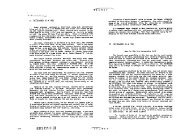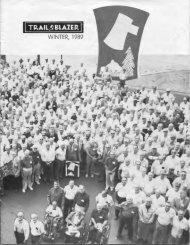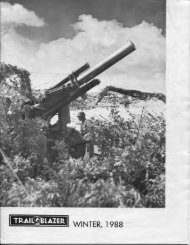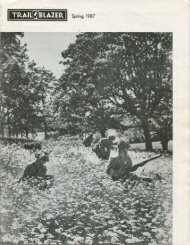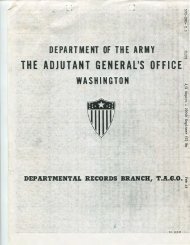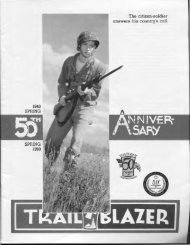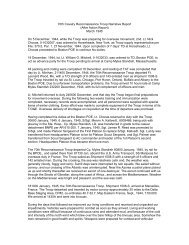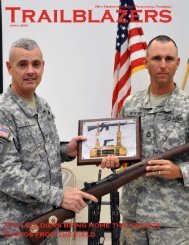Download - 70th Infantry Division Association
Download - 70th Infantry Division Association
Download - 70th Infantry Division Association
Create successful ePaper yourself
Turn your PDF publications into a flip-book with our unique Google optimized e-Paper software.
In direct support of the Bloody Axe for the attack were the 884th Field Artillery Battalion reinforced by the<br />
495th AFA, the 86th Field Artillery Battalion and the Cannon Company of the 276th. Attached units were:<br />
One platoon, Company C, and one platoon, Company D, 749th Tank Battalion; one platoon, 2<strong>70th</strong><br />
Engineer Battalion, and Company C, 99th Chemical Battalion, minus one platoon.<br />
The enemy position, as the plans for the attack were completed, extended from Marienau through the<br />
town of Forbach, along the southwest edge of Le Kleinwaldchen, and through Oeting to Behren. S-2<br />
estimated enemy units in contact to have a strength of 520 men, divided among the First and Second<br />
Battalions of the 880th Regiment and the Second Battalion of the 860th Regiment.<br />
An estimated 800 reserves in Forbach, Stiring-Wendel were reported to have left, moving in the direction<br />
of Saarbrucken. S-2 pointed out that they might be reinforcing other units in the area. The food situation<br />
in Forbach, Stiring-Wendel and Marieneau was bad, and typhoid was reported in Stiring-Wendel.<br />
One possible enemy action in the event of a strong attack was foreseen as delay on successive positions<br />
until reaching the fortified area south of Saarbrucken, where a deliberate defense could be employed.<br />
Preparatory to the attack, a forward dump of K and C rations was established at Bening, and an<br />
emergency ammunition dump at Cocheren. Also at Cocheren was an emergency gasoline dump. On the<br />
eve of the attack Company G relieved Company I, Company H relieved elements of Company M,<br />
Company L relieved Company B, and Company M relieved elements of Company D in the Company L<br />
sector.<br />
The Second Battalion came under <strong>Division</strong> control, as <strong>Division</strong> reserve, when the attack started. Since<br />
Company G was in position on our left flank, our new left limiting point on a much-reduced front for the<br />
attack was in the woods northeast of Morsbach, while our right limiting point at the start of the attack was<br />
in the vicinity of Gaubivingen. This concentrated the efforts of the Bloody Axe initially on the Oeting<br />
vicinity.<br />
The day before the attack S-1 listed replacements required as eight officers and 160 enlisted men.<br />
At 0001 on 17 February the attack moved out, as scheduled, with the companies first advancing to<br />
assault positions, and from these locations launching the main attack just before daylight.<br />
Advancing through a heavy fog that made visibility extremely limited, Company K was on the left of the<br />
Third Battalion and Company I on the right; Company B on the left of the First Battalion and Company C<br />
on the right.<br />
Initial objective was the Kleinwald-Fahrbert-Kelsberg Hills. Pressing on against enemy small-arms fire, the<br />
Third Battalion had taken its part of the first objective by 0820 and was reorganizing. The First Battalion<br />
also reached its first goal and then Company B entered the town of Oeting, while Company C moved<br />
forward to the east of the town. B Company had barely gained a foothold in Oeting, and L Company on<br />
the left was preparing to enter, when the advancing troops came under the fire of four self-propelled 88's.<br />
So intense was this fire that L was unable to enter the city and B could push forward no farther. Meanwhile<br />
C Company was progressing very slowly because of heavy small-arms fire from an anti-tank ditch.<br />
Late in the day the intensity of the 88 fire compelled B Company to withdraw and dig in south of the town.<br />
At dark, Companies I and K, occupying the Third Battalion's initial objective, Company A to the southeast<br />
of Oeting, Company B to the south and Company C, east, were all digging in for an all-around defense for<br />
the night. Active patrolling was conducted throughout the night.<br />
The first day of the attack had revealed the deadly effectiveness of enemy land and antipersonnel mines,<br />
a number of casualties having resulted from these weapons. Enemy resistance throughout the day had<br />
been chiefly small arms fire, however. His artillery and mortar fire had been very light, except for the 88's<br />
in Oeting. An outstanding development of this initial day was the efficiency displayed by the units of the<br />
276th in maintaining contact with each other--a vast improvement over the situation in the attack<br />
conducted 6-7 February in the same general area. The day's casualties were one killed and 56 wounded.<br />
The 276th had taken 50 prisoners.



